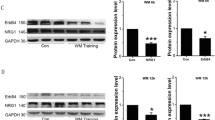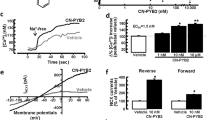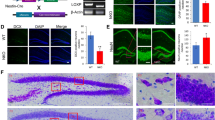Abstract
Ubiquitin-like with PHD and ring finger domains 2 (Uhrf2) is distributed in many brain regions, including the cortex and hippocampus. Decreased Uhrf2 expression is involved in neurodegenerative disease. A recent study showed Uhrf2 deletion impaired spatial memory; however, the mechanism remains elusive. In our study, we determined that Uhrf2+/− and Uhrf2−/− mice had significant learning and memory deficiencies in contextual fear conditioning (CFC) and the novel place recognition test but not in the novel object recognition test. Interestingly, there were no changes in the Uhrf2 protein levels in the hippocampus of C57BL6 mice after CFC training, which suggests Uhrf2 in adult mice may not be related to the formation of CFC long-term memory. Based on Nissl staining, Uhrf2 deletion caused neuropathological changes specifically in the crest of the dentate gyrus (DG), such as cell swelling, a vague outline and confused boundary; however, no changes were identified in the medial prefrontal cortex (mPFC). Transmission electron microscope assay further indicated a series of abnormal ultrastructure changes in neurons and glia in the DG crest. These results suggested that Uhrf2 deletion selectively blocked the development of the DG crest and impaired hippocampus-dependent learning and memory. Our study will facilitate a better understanding of the role of Uhrf2 protein in the central nervous system.




Similar content being viewed by others
References
Barbosa FF et al (2013) Differential cortical c-Fos and Zif-268 expression after object and spatial memory processing in a standard or episodic-like object recognition task. Front Behav Neurosci 7:112
Barker GR et al (2007) Recognition memory for objects, place, and temporal order: a disconnection analysis of the role of the medial prefrontal cortex and perirhinal cortex. J Neurosci 27(11):2948–2957
Bekinschtein P et al (2013) Role of medial prefrontal cortex serotonin 2A receptors in the control of retrieval of recognition memory in rats. J Neurosci 33(40):15716–15725
Bevins RA, Besheer J (2006) Object recognition in rats and mice: a one-trial non-matching-to-sample learning task to study ‘recognition memory’. Nat Protoc 1(3):1306–1311
Bi AL et al (2015) Myosin II regulates actin rearrangement-related structural synaptic plasticity during conditioned taste aversion memory extinction. Brain Struct Funct 220(2):813–825
Bronner C et al (2007) The UHRF family: oncogenes that are drugable targets for cancer therapy in the near future? Pharmacol Ther 115(3):419–434
Burgess N, Maguire EA, O’Keefe J (2002) The human hippocampus and spatial and episodic memory. Neuron 35(4):625–641
Carr VA, Rissman J, Wagner AD (2010) Imaging the human medial temporal lobe with high-resolution fMRI. Neuron 65(3):298–308
Chen R et al (2017) The 5-hydroxymethylcytosine (5hmC) reader UHRF2 is required for normal levels of 5hmC in mouse adult brain and spatial learning and memory. J Biol Chem 292(11):4533–4543
Cilenti L et al (2014) Inactivation of Omi/HtrA2 protease leads to the deregulation of mitochondrial Mulan E3 ubiquitin ligase and increased mitophagy. Biochim Biophys Acta 1843(7):1295–1307
Dossat AM et al (2017) Viral-mediated Zif268 expression in the prefrontal cortex protects against gonadectomy-induced working memory, long-term memory, and social interaction deficits in male rats. Neuroscience 340:243–257
Euston DR, Gruber AJ, McNaughton BL (2012) The role of medial prefrontal cortex in memory and decision making. Neuron 76(6):1057–1070
Fujimori A et al (1998) Cloning and mapping of Np95 gene which encodes a novel nuclear protein associated with cell proliferation. Mamm Genome 9(12):1032–1035
Garcia-Fuster MJ, Rhodes JS, Mandyam CD (2013) The role of dentate gyrus neurogenesis in neuropsychiatric disorders. Neural Plast 2013:584382
Ghavami S et al (2014) Autophagy and apoptosis dysfunction in neurodegenerative disorders. Prog Neurobiol 112:24–49
Gibson GE, Thakkar A (2017) Interactions of mitochondria/metabolism and calcium regulation in Alzheimer’s disease: a calcinist point of view. Neurochem Res 42(6):1636–1648
Gilbert PE, Kesner RP, Lee I (2001) Dissociating hippocampal subregions: double dissociation between dentate gyrus and CA1. Hippocampus 11(6):626–636
Goodrich-Hunsaker NJ, Hunsaker MR, Kesner RP (2005) Dissociating the role of the parietal cortex and dorsal hippocampus for spatial information processing. Behav Neurosci 119(5):1307–1315
Gu XH et al (2016) The flavonoid baicalein rescues synaptic plasticity and memory deficits in a mouse model of Alzheimer’s disease. Behav Brain Res 311:309–321
Guzowski JF et al (2001) Experience-dependent gene expression in the rat hippocampus after spatial learning: a comparison of the immediate-early genes Arc, c-fos, and zif268. J Neurosci 21(14):5089–5098
Hall J, Thomas KL, Everitt BJ (2001) Cellular imaging of zif268 expression in the hippocampus and amygdala during contextual and cued fear memory retrieval: selective activation of hippocampal CA1 neurons during the recall of contextual memories. J Neurosci 21(6):2186–2193
Jessberger S et al (2009) Dentate gyrus-specific knockdown of adult neurogenesis impairs spatial and object recognition memory in adult rats. Learn Mem 16(2):147–154
Jing X et al (2017) HDAC7 ubiquitination by the E3 Ligase CBX4 is involved in contextual fear conditioning memory formation. J Neurosci 37(14):3848–3863
Kee N et al (2007) Preferential incorporation of adult-generated granule cells into spatial memory networks in the dentate gyrus. Nat Neurosci 10(3):355–362
Kesner RP (2013) An analysis of the dentate gyrus function. Behav Brain Res 254:1–7
Kheirbek MA et al (2012) Neurogenesis and generalization: a new approach to stratify and treat anxiety disorders. Nat Neurosci 15(12):1613–1620
Kleschevnikov AM et al (2012) Deficits in cognition and synaptic plasticity in a mouse model of down syndrome ameliorated by GABAB receptor antagonists. J Neurosci 32(27):9217–9227
Lai M et al (2016) Multidimensional proteomics reveals a role of UHRF2 in the regulation of epithelial-mesenchymal transition (EMT). Mol Cell Proteom 15(7):2263–2278
Li Y et al (2004) NIRF induces G1 arrest and associates with Cdk2. Biochem Biophys Res Commun 319(2):464–468
Li W et al (2008) Genome-wide and functional annotation of human E3 ubiquitin ligases identifies MULAN, a mitochondrial E3 that regulates the organelle’s dynamics and signaling. PLoS One 3(1):e1487
Li WJ et al (2010) Anxiolytic effect of music exposure on BDNFMet/Met transgenic mice. Brain Res 1347:71–79
Li D et al (2013) Heritable gene targeting in the mouse and rat using a CRISPR-Cas system. Nat Biotechnol 31(8):681–683
Liang C et al (2013) Identification of UHRF1/2 as new N-methylpurine DNA glycosylase-interacting proteins. Biochem Biophys Res Commun 433(4):415–419
Lu S et al (2014) Ubiquitin-like with PHD and ring finger domains 2 is a predictor of survival and a potential therapeutic target in colon cancer. Oncol Rep 31(4):1802–1810
Luo T et al (2013) Uhrf2 is important for DNA damage response in vascular smooth muscle cells. Biochem Biophys Res Commun 441(1):65–70
McHugh TJ et al (2007) Dentate gyrus NMDA receptors mediate rapid pattern separation in the hippocampal network. Science 317(5834):94–99
Mori T et al (2002) NIRF, a novel RING finger protein, is involved in cell-cycle regulation. Biochem Biophys Res Commun 296(3):530–536
Mori T et al (2004) NIRF is a ubiquitin ligase that is capable of ubiquitinating PCNP, a PEST-containing nuclear protein. FEBS Lett 557(1–3):209–214
Mori T et al (2011) NIRF constitutes a nodal point in the cell cycle network and is a candidate tumor suppressor. Cell Cycle 10(19):3284–3299
Mori T et al (2012) NIRF/UHRF2 occupies a central position in the cell cycle network and allows coupling with the epigenetic landscape. FEBS Lett 586(11):1570–1583
Morici JF, Bekinschtein P, Weisstaub NV (2015) Medial prefrontal cortex role in recognition memory in rodents. Behav Brain Res 292:241–251
Neher T, Cheng S, Wiskott L (2015) Memory storage fidelity in the hippocampal circuit: the role of subregions and input statistics. PLoS Comput Biol 11(5):e1004250
Ozawa T, Yamada K, Ichitani Y (2014) Hippocampal BDNF treatment facilitates consolidation of spatial memory in spontaneous place recognition in rats. Behav Brain Res 263:210–216
Petsophonsakul P et al (2017) Memory formation orchestrates the wiring of adult-born hippocampal neurons into brain circuits. Brain Struct Funct 222:2585–2601
Pichler G et al (2011) Cooperative DNA and histone binding by Uhrf2 links the two major repressive epigenetic pathways. J Cell Biochem 112(9):2585–2593
Qian G et al (2015) NIRF, a novel ubiquitin ligase, inhibits hepatitis B virus replication through effect on HBV core protein and H3 histones. DNA Cell Biol 34(5):327–332
Reeves MB et al (2007) Complex I binding by a virally encoded RNA regulates mitochondria-induced cell death. Science 316(5829):1345–1348
Reinhardt P et al (2013) Genetic correction of a LRRK2 mutation in human iPSCs links parkinsonian neurodegeneration to ERK-dependent changes in gene expression. Cell Stem Cell 12(3):354–367
Schmidt SD et al (2017) Modulation of the consolidation and reconsolidation of fear memory by three different serotonin receptors in hippocampus. Neurobiol Learn Mem 142(Pt A):48–54
Sinha K et al (2013) Oxidative stress: the mitochondria-dependent and mitochondria-independent pathways of apoptosis. Arch Toxicol 87(7):1157–1180
Spruijt CG et al (2013) Dynamic readers for 5-(hydroxy)methylcytosine and its oxidized derivatives. Cell 152(5):1146–1159
Thomas KL, Hall J, Everitt BJ (2002) Cellular imaging with zif268 expression in the rat nucleus accumbens and frontal cortex further dissociates the neural pathways activated following the retrieval of contextual and cued fear memory. Eur J Neurosci 16(9):1789–1796
van Strien NM, Cappaert NL, Witter MP (2009) The anatomy of memory: an interactive overview of the parahippocampal-hippocampal network. Nat Rev Neurosci 10(4):272–282
Wang F et al (2012) NIRF is frequently upregulated in colorectal cancer and its oncogenicity can be suppressed by let-7a microRNA. Cancer Lett 314(2):223–231
Wang DD et al (2014) Transcriptome profiling analysis of the mechanisms underlying the BDNF Val66Met polymorphism induced dysfunctions of the central nervous system. Hippocampus 24(1):65–78
Winters BD, Saksida LM, Bussey TJ (2010) Implications of animal object memory research for human amnesia. Neuropsychologia 48(8):2251–2261
Wu C et al (2009) BioGPS: an extensible and customizable portal for querying and organizing gene annotation resources. Genome Biol 10(11):R130
Xu N et al (2015) Hippocampal Wnt3a is necessary and sufficient for contextual fear memory acquisition and consolidation. Cereb Cortex 25(11):4062–4075
Yang ST et al (2014) Neuronal representation of working memory in the medial prefrontal cortex of rats. Mol Brain 7:61
Yau SY et al (2016) Impaired bidirectional NMDA receptor dependent synaptic plasticity in the dentate gyrus of adult female Fmr1 heterozygous knockout mice. Neurobiol Dis 96:261–270
Yu H et al (2012) Variant brain-derived neurotrophic factor Val66Met polymorphism alters vulnerability to stress and response to antidepressants. J Neurosci 32(12):4092–4101
Zeng S et al (2017) E3 ligase UHRF2 stabilizes the acetyltransferase TIP60 and regulates H3K9ac and H3K14ac via RING finger domain. Protein Cell 8(3):202–218
Zhang HT et al (2015) Cold-inducible RNA-binding protein inhibits neuron apoptosis through the suppression of mitochondrial apoptosis. Brain Res 1622:474–483
Zhang T et al (2017) UHRF2 decreases H3K9ac expression by interacting with it through the PHD and SRA/YDG domain in HepG2 hepatocellular carcinoma cells. Int J Mol Med 39(1):126–134
Zhou T et al (2014) Structural basis for hydroxymethylcytosine recognition by the SRA domain of UHRF2. Mol Cell 54(5):879–886
Zhou WJ et al (2016) The antidepressant roles of Wnt2 and Wnt3 in stress-induced depression-like behaviors. Transl Psychiatry 6(9):e892
Zuo H et al (2014) Neural cell apoptosis induced by microwave exposure through mitochondria-dependent caspase-3 pathway. Int J Med Sci 11(5):426–435
Acknowledgements
This work is supported by the National Natural Science Foundation of China (Grant Numbers: 31571100, 91432306), Shandong Province Natural Science Foundation [grant number: ZR2014CM036] and the Fundamental Research Funds of Shandong University.
Author information
Authors and Affiliations
Corresponding author
Electronic supplementary material
Below is the link to the electronic supplementary material.
Rights and permissions
About this article
Cite this article
Chen, XR., Sun, SC., Teng, SW. et al. Uhrf2 deletion impairs the formation of hippocampus-dependent memory by changing the structure of the dentate gyrus. Brain Struct Funct 223, 609–618 (2018). https://doi.org/10.1007/s00429-017-1512-1
Received:
Accepted:
Published:
Issue Date:
DOI: https://doi.org/10.1007/s00429-017-1512-1




